

Of course, for those situations when you prefer to have a sharper background, you can always shoot the Tamron at a smaller aperture. There’s a pretty dramatic difference in the appearance of the background between f/5.6 and f/2.8, though the difference between 50mm and 70mm is modest (but easily visible).

Here I’ve taken a photo with a Sony 16-50mm OSS kit lens at 50mm, f/5.6, and the Tamron 17-70 at 50 and 70mm, f/2.8. One of the advantages of using a large aperture lens is that it creates shallow depth of field, which has the potential to smooth out distracting details in the background and focus attention on the subject. There were some changes as I stopped the lenses down, though.
#Sigma 24 70 2.8 sony stabilization full
I expected the full frame lens to have a greater advantage away from the center of the frame, but again, they were very similar. In the center, wide open, the two lenses produce excellent resolution, and this time, the Tamron and Sigma are practically identical… though the Sigma prime may be measurably sharper. Note the text on the “Park Closed” sign not for from the center, below: the Sigma 70mm f/2.8 Macro my Sigma 70mm f/2.8 ART Macro prime lens is probably the sharpest lens that I own at that focal length, so I decided it would be worthwhile to see how the Tamron 17-70 f/2.8 compares. I don’t notice a difference at f/8, though. However, despite its improvement at the edge of the frame, the 17-70 is still just slightly softer than the 28-75. I’d be hard pressed to choose which is better… and that’s more in line with what I was expecting.Īt f/4, the 28-75 still lags behind the 17-70 a bit, but out towards the edge, the full-frame lens has grown significantly sharper, and is clearly providing better resolution than the 17-70 (which is also still quite good).Īt f/5.6 and beyond, the Tamron 28-75 catches up in the center of the frame, and they’re identical for all practical purposes there. Out at the edge of the frame, both in the center of the edge and the upper edge, the differences are very modest. Take a look at the tree branches in the lower, center of the frame, especially where they’re against the dark shadows towards the left. Matthew Gore This image, shot at 70mm, is an overview of the images from which the crops below were taken.īut as you’ll likely notice in the images above, at 70mm, the Tamron 17-70 f/2.8 VC is actually providing better resolution than the full-frame 28-75mm.

Here, I expected the full frame lenses to benefit from the “sweet spot” effect, and was mostly hoping that the 17-70 would come close to their resolution away from the center. the Tamron 28-75 f/2.8 my initial tests, I compared the resolution of the Tamron 17-70 against the Tamron 28-75 and 17-28mm lenses, where they overlapped with the 17-70. I began my testing by comparing it to the kit 16-50mm f/3.5-5.6 OSS lens on a Sony a6300, and the results were predictably bad for the Sony, which looked like an ugly mess in comparison (see video for comparison). As you’ll see in the examples below, the center sharpness of the Tamron 17-70mm is as good as any lens that I compared it against, including my Sigma 70mm f/2.8 Macro prime lens. It’s especially strong at the wide end, but the loss at 70mm is negligible and still excellent. In my testing, the Tamron 17-70 f/2.8 VC showed remarkably good resolution throughout the zoom range, from center to edge. Shot with a Sony a6300 and Tamron 17-70mm f/2.8 VC lens. Matthew Gore North Head Lighthouse, near Long Beach, WA. So is the Tamron as good as it looks? Yes, but of course, it’s not really perfect. The next closest competitor is the Sony 16-55 f/2.8, a $1399 lens without image stabilization. The Tamron 17-70 f/2.8 VC for Sony E-mount is a lens without much competition right now: it has a wide to mid-telephoto zoom range (equivalent to a 25.5-105mm equivalent angle of view), a constant f/2.8 aperture available, image stabilization, and excellent image quality, all for about $799.


 0 kommentar(er)
0 kommentar(er)
